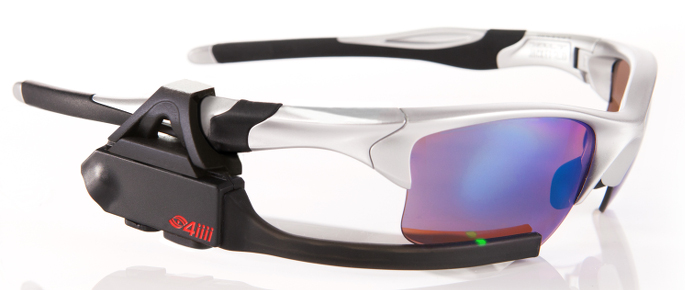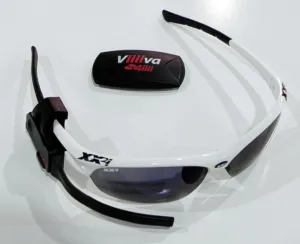In a world dominated by stories of 4K (and 8K and even higher) resolution displays, it’s good to be reminded from time to time that very small amounts of data can still be useful, and that these can be displayed on very simple devices. One extreme example of this simplicity is a wearable, head-mounted display for exercise enthusiasts: the Sportiiii [http://4iiii.com/product/sportiiii/] from the company 4iiii [http://4iiii.com].
This device looks like a microphone boom that clamps onto one earpiece of your glasses; it might easily be mistaken for a Bluetooth headset. Instead, the boom has a line of seven colored LEDs. There’s a green one in the center of the line, bracketed by yellow, orange, red, and blue LEDs in sequence.
The concept is simple. You set a target for your workout, and when you hit that mark, the center green LED will glow. Start slacking, and the lights to the left will indicate how far off your pace you are performing. On the other hand, the lights to the right will light if you start over exerting.
The beauty of the wireless device is that it can display data from a variety of different devices. The key is that they must support the ANT+ standard [http://fitnesselectronicsblog.com/500-2/], which is a low-data-rate wireless protocol that has been adopted by many exercise and fitness equipment makers including Garmin, Timex, Wahoo, Samsung, and Magellan. Supported devices include heart rate monitors, gym equipment, bicycles, and much more.
This means that you can track different metrics for different workouts. You establish the different target zones using a program on your Apple or Windows computer, or iOS or Android smartphone. For example, you can set the limits for your cadence when pedalling a bike, or your heart rate while running. You can even use the Sportiiii to track different metrics; a double-tap lets you switch between sensors. And it’s easy to call up different stored settings on your smartphone if you want to make changes for different parts of your workout.

Display Daily Comment
Sure, 4iiii could have gone with a full color, high definition pixel matrix display to convey this information, or possibly even more data. But it likely would cost a lot more than than the $150 list price for the Sportiiii, and really would not tell you much more useful information. What more do you really need to know other than “work harder” or “ease up a bit”?
E.F. Schumacher, author of “Small Is Beautiful,” was a proponent of “appropriate technology.” This means making a device only as complicated or powerful as it needs to be. I think that the Sportiiii is a good example of a display product that demonstrates this concept. (AP)

